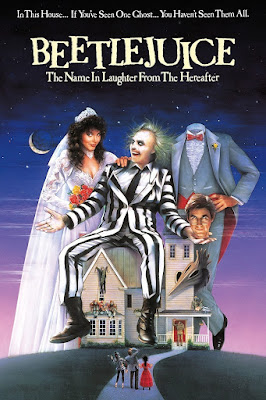 |
| From http://crypticrock.com/wp-content/uploads /2013/07/halloween-poster.jpeg |
Director: John Carpenter
Screenplay: John Carpenter and
Debra Hill
Cast: Jamie Lee Curtis (as Laurie
Strode); Nick Castle (as Michael Myers); Donald Pleasence (as Dr. Sam Loomis);
Charles Cyphers (as Sheriff Leigh Brackett); Nancy Kyes (as Annie Brackett); P.
J. Soles (as Lynda Van Der Klok)
A Night of a Thousand Horror (Movies) #55
 It'll be impossible to add
anything else to the view of Halloween
analytically or in aesthetic. In fact the most interesting thing from my
perspective I can add is that it was an immensely slow period of rewatches
before I held Halloween as beyond an
okay film to one of the best horror films I've seen from the seventies.
Probably the more surprisingly thing for me revisiting it, since this review is
inevitably going to just going to praise it to the hilt, is how for what
innovated the slasher as a fully formed genre it was followed by so many films
which fell below completely in terms of quality next to it. There's plenty of
fun slashers and I've so many to still see, always willing to give a chance to
one I haven't seen, but the level of quality in terms of how well made and
beautiful Halloween is, even if it deals
with exceptionally grim subject matter, is an entire mountain higher than most
of the films made to cash in on it eventually. This is something which is
baffling in hindsight as in this period of the later seventies and eighties,
you can find films which effectively cashed in on popular mainstream hits which
are yet capable of being great movies in themselves.
It'll be impossible to add
anything else to the view of Halloween
analytically or in aesthetic. In fact the most interesting thing from my
perspective I can add is that it was an immensely slow period of rewatches
before I held Halloween as beyond an
okay film to one of the best horror films I've seen from the seventies.
Probably the more surprisingly thing for me revisiting it, since this review is
inevitably going to just going to praise it to the hilt, is how for what
innovated the slasher as a fully formed genre it was followed by so many films
which fell below completely in terms of quality next to it. There's plenty of
fun slashers and I've so many to still see, always willing to give a chance to
one I haven't seen, but the level of quality in terms of how well made and
beautiful Halloween is, even if it deals
with exceptionally grim subject matter, is an entire mountain higher than most
of the films made to cash in on it eventually. This is something which is
baffling in hindsight as in this period of the later seventies and eighties,
you can find films which effectively cashed in on popular mainstream hits which
are yet capable of being great movies in themselves.
Surprisingly, even in the context
of slasher films and their constant repetition of plot lines, Halloween is simplistic in plot even
next to its sequels, as while later films including Friday the 13 (1980) would have more complicated back stories, all
there is about the first Halloween
is a boy named Michael Myers who killed his older sister then, after escaping a
mental asylum years later, targets three young woman (Jamie Lee Curtis as
Laurie Strode, Nancy Kyes (as Annie
Brackett) and P. J. Soles as Lynda
Van Der Klok). No folktale mythology, little in terms of an actual body count,
and very minimal even in the extremely threadbare slashers of later years, only
Donald Pleasance as Myers' psychologist Dr. Sam Loomis giving chase qualifies
as a subplot. It was a deceptively simple, explaining why my younger self
wasn't interested in the film at first, and there's little to Myers barring
being a figure who stalks a couple of suburbia houses, its economy more frightening
in this especially when you view it as a cinematic mirror of the serial
killings starting to take place in the late sixties onwards in the USA. This
reality, of a kid who kills for no reason, taps directly into then-modern idea
in horror films of remorselessness, as Loomis says there's nothing behind
Myers' eyes, crossed with the supernatural by making him a literal bogeyman for
Tommy Doyle (Brian Andrews), the
young boy Laurie is babysitting, to see outside his window at night and be
terrified of. Because of Dean Cundey's
awe-inspiring cinematography there are times it feels like Myers literally disappears
and re-materialises from the shadows like a spectre.
 |
| From https://lintvkimt.files.wordpress.com/2014/10/halloween3.png |
It of course helps that the people he terrorises are written and acted like real people. It's a problem with horror cinema in general, but even in fun and ridiculous movies, unless you're a great writer of esoteric or funny dialogue, I cannot stand characters who merely speak in quips and generic exposition. Even though I appreciate fans of cheese in their movies, who can cultivate and cherish it like the actual connoisseurs of cheeses made from curdled milk, only in rare cases (i.e. trying to comprehend any of the dialogue of the Canadian shot-on-video film Things (1989)) do I appreciate the random in dialogue. At least with European and Italian cinema at this period, even if the dubbed dialogue could be absurd,they kept the characters quiet for large portions of them and let the mood speak for itself,, whilst the worst stereotype of a slasher (or any horror film) is incessantly speaking and talks too much about little. The combination of John Carpenter openly admitting his influence from classic Hollywood and the unsung quality of the late Debra Hill as a writer means that, alongside great performances, you have characters you care completely for in the context of a minimalistic chiller. Jamie Lee Curtis in particular stood out this time and its baffling that people created the virginal Final Girl stereotype from the Laurie Strode character when its completely alien, feeling like a puritanical bastardisation of a more complicated and interesting figure - a sarcastic but thoughtful figure, who smokes pot but is utterly reliable as a person, merely shy around boys and has other peoples' work begrudgingly dumped on her lap including by her friends. For her first performance in a film, its great acting by Lee Curtis even when she has to play the moments of screaming and cowering from Myers before she starts to retaliate back.
As a horror film, the languid
pace is perfect. Cundey's
cinematography adds a realistic, Americana look in the daytime scenes but at
night gives a story almost grounded in reality a phantasmagoric edge in how
Michael Myers blends into the shadows. The music by Carpenter himself is iconic, tapping into similar unease from the
use of electronic music. What's also worth motioning, whilst a film about death
and terror, is that it lavishes a love to Halloween the holiday itself. Old horror
films playing on the televisions, including The Thing from Another World (1951) as a premonition of Carpenter's
career, to the various appearances of pumpkins beyond the ominous opening
credits. Barring Halloween III: Season
of the Witch (1982), none of the later films' references to ancient ritual
and Samhain had any sense of real mythos to it, merely terrible script writing,
completely out of place of a very American phantom of a killer who murders indiscriminately
but also in treating Halloween as a festival as a homespun and warm holiday, of
trick and treating to dressing up in costumes. This is better as there is
preferably instead a sense of humanity felt, but as a result the horrible fear of
a person in a white William Shatner
mask stalking around becomes a real terror in a local community. Not a lot of
the slashers I've seen have ever had the sense of a community, merely setting
with stock types, to make the terror more disturbing, so the sense of frivolity
and childhood innocence found in Haddonfield's suburbia is more startling in
hindsight to what horrible things will happen in the narrative. It's a line
where, when Annie's father Sheriff Leigh Brackett (Charles Cyphers) scares Laurie and says everyone deserves a scare
on Halloween, that is the core of the namesake film over it, less the gore and
big hair of the eighties which are utterly alien to the viewers, but a creepy
ghost ride which is yet so close to the places its original audience would be
living it that it has grounded, real chill to it. Watching it many Halloweens
like many others, it's both a comfort film but, especially with its almost
surreal ending where Carpenter shows
shots of empty rooms after the tragedy has taken place, also a film that efficiently
scrapes a primal nerve of discomfort every single time I view it now.
 |
| From http://2.bp.blogspot.com/-TmfF10TKQPM/VEe6slrjkpI/ AAAAAAABB_c/HV2ay-GLeus/s1600/Halloween,%2B1978%2B(6).png |
































